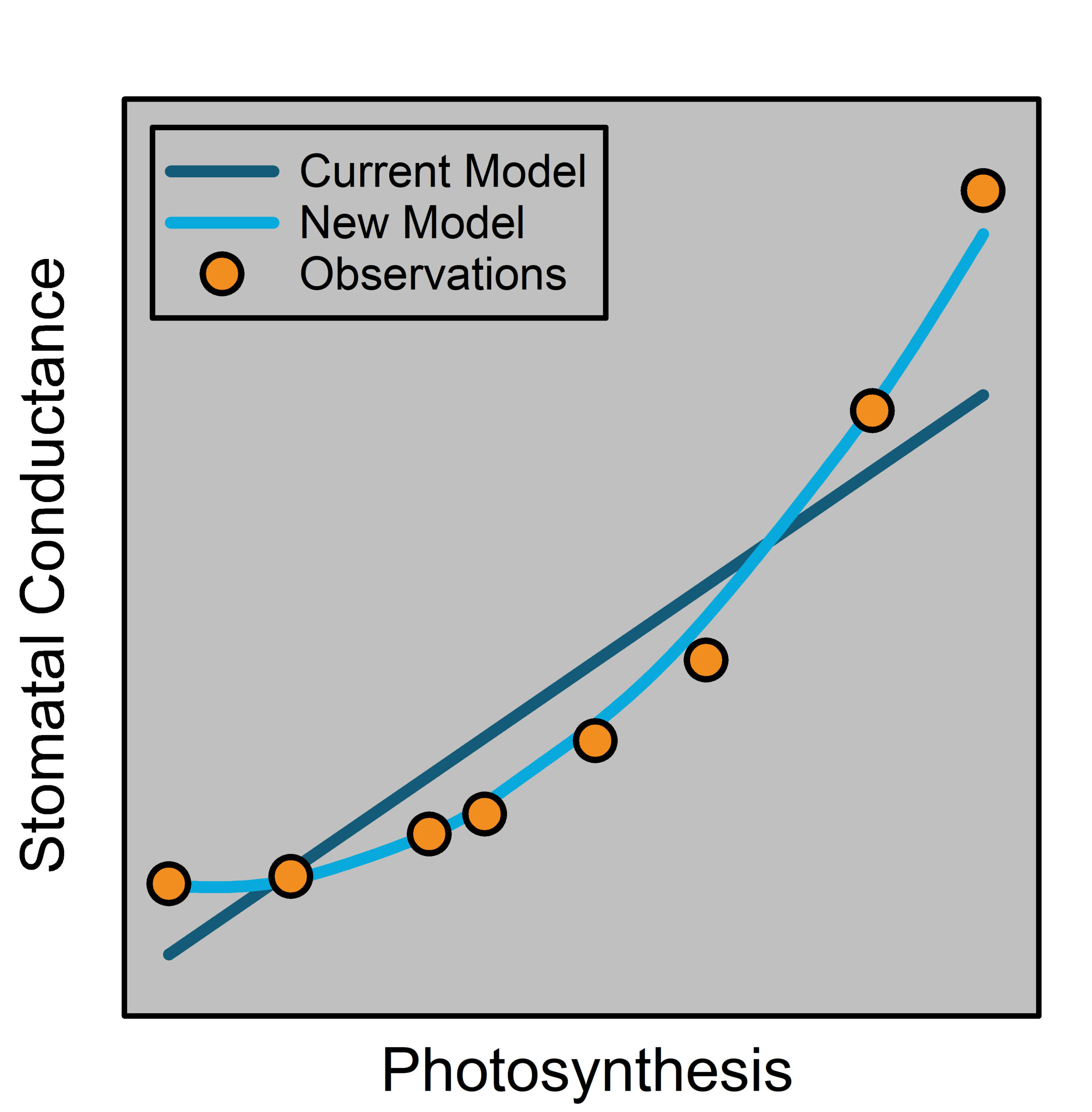January 28, 2022
A New Model of Stomatal Conductance Enables Improved Representation of Transpiration in Earth System Models
Measurement of stomatal conductance in tropical trees challenges current model assumptions and improves model parameterization.

Current stomatal models assume a linear relationship between stomatal conductance and photosynthesis for given environmental conditions. Data from this study challenges this assumption, and this new model does a better job representing the data.
[Reprinted with permission from Lamour, J., et al. “An Improved Representation of the Relationship between Photosynthesis and Stomatal Conductance Leads to More Stable Estimation of Conductance Parameters and Improves the Goodness-of-Fit Across Diverse Datasets.” Global Change Biology 28(11), 3537–56 (2022). DOI: 10.1111/gcb.16103. © 2023 John Wiley & Sons Ltd.]
The Science
Stomata play a central role in plants by controlling the exchange of water vapor and carbon dioxide (CO2) with the atmosphere. Researchers with the Next-Generation Ecosystem Experiments-Tropics (NGEE-Tropics) measured the response of stomatal conductance and photosynthesis in six tropical species at different leaf ages. Contrary to current model assumptions, data from this study showed that the response of stomata to photosynthesis was non-linear and accounting for non-linearity resulted in a notable impact on model simulations of CO2 and water vapor fluxes.
The Impact
Earth system models represent the exchange of CO2 and water vapor with models of stomatal conductance. The key parameter in stomatal models describes the water use efficiency of vegetation and, in current models, is the slope of an assumed linear relationship between stomatal conductance and photosynthesis for given set of environmental conditions. This research found that this assumption of linearity was false and developed an improved representation of stomatal conductance. The proposed model accounts for the non-linearity and enables robust parameterization of water use efficiency across a range of environmental conditions.
Summary
Measurement of the response of stomatal conductance to changes in photosynthesis are rare, particularly in the tropics. Researchers measured the response of stomatal conductance and photosynthesis to irradiance in six tropical species at different leaf ages. Contrary to current stomatal model assumptions, results showed that the relationship between stomatal conductance and photosynthesis was not linear, challenging the key assumption that water use efficiency for a leaf is constant. Study data showed that increasing photosynthesis resulted in a small increase in stomatal conductance at low irradiance, but a much larger increase at high irradiance. As a result, the research team reformulated the popular Unified Stomatal Optimization (USO) model to account for this phenomenon and to enable consistent estimation of key model parameters. This modification of the USO model improved the goodness-of-fit and reduced bias, enabling robust estimation of conductance parameters at any irradiance. In addition, this modification revealed previously undetectable relationships between the stomatal slope parameter and other leaf traits. Results also revealed nonlinear behavior between stomatal conductance and photosynthesis in independent data sets that included data collected from plants grown at elevated CO2 concentration. This study proposes that this empirical modification of the USO model can improve the measurement of stomatal conductance parameters and the estimation of plant and ecosystem-scale CO2 and water vapor fluxes.
Principal Investigator
Alistair Rogers
Brookhaven National Laboratory
arogers@bnl.gov
Program Manager
Brian Benscoter
U.S. Department of Energy, Biological and Environmental Research (SC-33)
Environmental System Science
brian.benscoter@science.doe.gov
Funding
This work was supported by the Next-Generation Ecosystem Experiments-Tropics (NGEE–Tropics) project that is supported by the Biological and Environmental Research (BER) Program within the U.S. Department of Energy’s (DOE) Office of Science. This work was also supported through DOE Contract Nos. DE-SC0012704 to Brookhaven National Laboratory and DE-SC0018277.
References
Lamour, J., et al. "An Improved Representation of the Relationship Between Photosynthesis and Stomatal Conductance Leads to More Stable Estimation of Conductance Parameters and Improves the Goodness-of-Fit Across Diverse Datasets." Global Change Biology 28 (11), 3537–56 (2022). https://doi.org/10.1111/gcb.16103.

